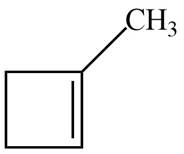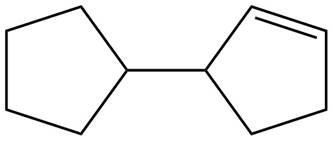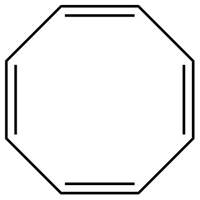
Concept explainers
(a)
Interpretation: The number of rings and number of pi bonds in A is to be determined. And one possible structure is to be drawn.
Concept introduction: Degree of unsaturation is used to determine the total number of rings and pi bonds present in compound by just looking at the molecular formula. It does not specify the total number of rings and total number of pi bonds individually.
Answer to Problem 12.35P
The number of pi bonds and number of rings in A is one. The possible structure is given in Figure 1.
Explanation of Solution
For compound A:
Before hydrogenation, the molecular formula is
The maximum number of
The maximum number of
The number of
Substitute the values of maximum number of
The degree of unsaturation is calculated by the formula,
Hence, the degree of unsaturation before hydrogenation is two.
After hydrogenation, the molecular formula is
The maximum number of
The maximum number of
The number
Substitute the values of maximum number of
The degree of unsaturation is calculated by the formula,
Hence, the degree of unsaturation after hydrogenation is one.
The number of pi bonds in A is calculated by the formula,
Substitute the values of degree of unsaturation before hydrogenation and degree of unsaturation after hydrogenation in the above formula.
Hence, the number of pi bonds is one.
Number of rings is calculated by the formula,
Substitute the values of degree of unsaturation and number of pi bonds in the above formula.
Hence, the number of rings is one.
The possible structure for A is,

Figure 1
The number of pi bonds and number of rings in A is one. The possible structure is given in Figure 1.
(b)
Interpretation: The number of rings and number of pi bonds in B is to be determined. And one possible structure is to be drawn.
Concept introduction: Degree of unsaturation is used to determine the total number of rings and pi bonds present in compound by just looking at the molecular formula. It does not specify the total number of rings and total number of pi bonds individually.
Answer to Problem 12.35P
The number of pi bonds and number of rings in B is one and two respectively. The possible structure is given in Figure 2.
Explanation of Solution
For compound B:
Before hydrogenation, the molecular formula is
The maximum number of
The maximum number of
The number of
Substitute the values of maximum number of
The degree of unsaturation is calculated by the formula,
Hence, the degree of unsaturation before hydrogenation is three.
After hydrogenation, the molecular formula is
The maximum number of
The maximum number of
The number
Substitute the values of maximum number of
The degree of unsaturation is calculated by the formula,
Hence, the degree of unsaturation after hydrogenation is two.
The number of pi bonds in A is calculated by the formula,
Substitute the values of degree of unsaturation before hydrogenation and degree of unsaturation after hydrogenation in the above formula.
Hence, the number of pi bonds is one.
Number of rings is calculated by the formula,
Substitute the values of degree of unsaturation and number of pi bonds in the above formula.
Hence, the number of rings is two.
The possible structure for B is,

Figure 2
The number of pi bonds and number of rings in B is one and two respectively. The possible structure is given in Figure 2.
(c)
Interpretation: The number of rings and number of pi bonds in B is to be determined. And one possible structure is to be drawn.
Concept introduction: Degree of unsaturation is used to determine the total number of rings and pi bonds present in compound by just looking at the molecular formula. It does not specify the total number of rings and total number of pi bonds individually.
Answer to Problem 12.35P
The number of pi bonds and number of rings in C is four and one respectively. The possible structure is given in Figure 3.
Explanation of Solution
For compound C:
Before hydrogenation, the molecular formula is
The maximum number of
The maximum number of
The number of
Substitute the values of maximum number of
The degree of unsaturation is calculated by the formula,
Hence, the degree of unsaturation before hydrogenation is five.
After hydrogenation, the molecular formula is
The maximum number of
The maximum number of
The number
Substitute the values of maximum number of
The degree of unsaturation is calculated by the formula,
Hence, the degree of unsaturation after hydrogenation is one.
The number of pi bonds in A is calculated by the formula,
Substitute the values of degree of unsaturation before hydrogenation and degree of unsaturation after hydrogenation in the above formula.
Hence, the number of pi bonds is four.
Number of rings is calculated by the formula,
Substitute the values of degree of unsaturation and number of pi bonds in the above formula.
Hence, the number of rings is one.
The possible structure for C is,

Figure 3
The number of pi bonds and number of rings in C is four and one respectively. The possible structure is given in Figure 3.
Want to see more full solutions like this?
Chapter 12 Solutions
Organic Chemistry
- ASP please....arrow_forwardNonearrow_forwardConsider the structure of 1-bromo-2-fluoroethane. Part 1 of 2 Draw the Newman projection for the anti conformation of 1-bromo-2-fluoroethane, viewed down the C1-C2 bond. ✡ ぬ Part 2 of 2 H H F Br H H ☑ Draw the Newman projection for the gauche conformation of 1-bromo-2-fluoroethane, viewed down the C1-C2 bond. H F Br H Harrow_forward
- Please help me answer this question. I don't understand how or where the different reagents will attach and it's mostly due to the wedge bond because I haven't seen a problem like this before. Please provide a detailed explanation and a drawing showing how it can happen and what the final product will look like.arrow_forwardWhich of the following compounds is the most acidic in the gas phase? Group of answer choices H2O SiH4 HBr H2Sarrow_forwardWhich of the following is the most acidic transition metal cation? Group of answer choices Fe3+ Sc3+ Mn4+ Zn2+arrow_forward
- Based on the thermodynamics of acetic acid dissociation discussed in Lecture 2-5, what can you conclude about the standard enthalpy change (ΔHo) of acid dissociation for HCl? Group of answer choices You cannot arrive at any of the other three conclusions It is a positive value It is more negative than −0.4 kJ/mol It equals −0.4 kJ/molarrow_forwardPLEASE HELP URGENT!arrow_forwardDraw the skeletal structure corresponding to the following IUPAC name: 7-isopropyl-3-methyldecanearrow_forward
